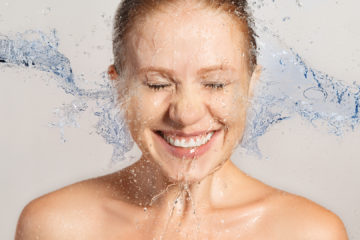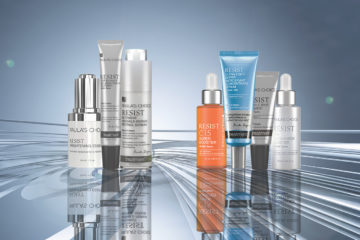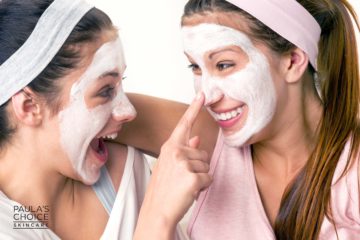Chemical Exfoliation: A Cheat Sheet to The Scariest Sounding Skincare Thing That’s Actually Good for You

Article Index:
- What Do Chemical Exfoliators Do?
- Why Shouldn’t I Stick to My Scrub?
- What is AHA?
- Types of AHA
- What is BHA?
- Exfoliator Acidity
- How to Use & Side Effects
- Using AHA and BHA Together?
- Where to Buy?
Skin naturally sheds built-up layers of dead cells, but this process slows dramatically as we get older. Thankfully, chemical exfoliation can help with that! Besides aging, other external factors such as sun damage and environmental exposure can contribute significantly to the slowing down of our natural exfoliating process. The result of all this is dull, dehydrated, and prematurely aged skin.
Here at Paula’s Choice, we believe that we’re the industry leading experts when it comes to exfoliators and exfoliating. We have probably the widest range of AHA & BHA exfoliators made for all skin types and a wide range of concerns! But what exactly are AHA and BHA exfoliators (a.k.a. chemical exfoliators), and the difference between them?
The quick and dirty answer is this: AHA works on the uppermost layers of the skin to give it a smoother appearance. AHA’s also have hydrating properties, hence it’s usually recommended for those with drier skin. BHA’s on the hand works in the deeper layers of the skin because it’s oil soluble. BHA is a great choice for those who are dealing with acne and clogged pores, but also for general anti-aging benefits.
What Do Chemical Exfoliators Do?
While it may sound scary, chemical exfoliation is actually the safest and easiest way to gently exfoliate your skin yet providing beyond superficial benefits.
Chemical exfoliators which contain AHA and BHA all function in a similar manner. These exfoliators basically work by breaking down the ‘glue’ which holds skin cells together and loosening them to reveal the new skin underneath.
One common misconception we must clarify is that Retinol is NOT an exfoliator. It works fundamentally different by ‘telling’ skin cells to develop normally. It does not loosen the bond between skin cells. You can learn more about Retinol here.
We believe that exfoliation is such a crucial step in your skincare routine because it can address so many concerns easily. Exfoliation inherently increases skin cell turnover. This means that the rate where new skin cells are produced is faster because it has a clearer path to the surface without all the old, dead cells blocking the way. This is how exfoliation can bring about general anti-aging benefits too!
Why Shouldn’t I Stick to My Scrub?
When we think ‘exfoliation’, many of us have that image of using something to rub or scrub to remove dead skin. This is actually the harshest way of exfoliating, which at best provides superficial results. This type of exfoliation, typically called physical or mechanical exfoliation, only removes the very topmost layer of skin. Even the weakest chemical exfoliators can work on a deeper level than physical exfoliators.
This is not to say that you should totally avoid physical exfoliation. The problem with many physical exfoliators is that they typically use overly abrasive ingredients with uneven edges that can cause micro-tears on the skin. The other kinds which do not contain these uneven edges usually contain plastic-based microbeads which are non-biodegradable and have an immense environmental impact.
The best bet if you’re looking for physical or mechanical exfoliation is to just use a gentle washcloth! Also, if you shave, that is also considered as a physical exfoliating process. But, nothing beats chemical exfoliating still.
What is AHA?
AHA or Alpha Hydroxy Acids are a group of water-soluble ingredients that exfoliate the topmost layers of skin. AHA’s are naturally found in many food products such as dairy and fruit, but it can be synthesized as well.
Properly formulated AHA’s can deliver multiple benefits including more radiant, firmer, hydrated, and smoother skin. AHA’s are preferred for those with drier skin, and for skin that’s sun damaged.
There are also multiple types of AHA to choose from to suite skins with different sensitivities. There is a direct correlation between gentleness and effectiveness when it comes to the different types of AHA’s. The larger the molecule of the type of AHA, the gentler, but the less effective it is because of its inability and/or speed of skin penetration.
Typical concentrations range between 4-15%, although higher concentrations can be found in peels. For regular exfoliation, we generally recommend concentrations between 5-10%.
Types of AHA
Glycolic Acid
The most commonly used type of AHA due to it being the most researched and its track record of performance. Glycolic acid is considered to be the gold standard of AHA’s.
It has a small molecule size, so it has a greater ability to penetrate the uppermost layers of skin. Glycolic acid is a humectant– this means that it helps to draw water to the upper layers of skin to keep it moisturized.
Glycolic acid is derived from sugarcane, however, synthesized glycolic acid is typically used in skincare products because of it being easier to stabilize with other ingredients. There are generally no other benefits/drawbacks to using naturally derived or synthesized ingredients.
Lactic Acid
The second-most commonly used type of AHA, and does everything glycolic acid does, just slower and gentler. Commonly derived from milk, lactic acid is a slightly larger molecule, hence its slower penetration rate. Lactic acid is still effective enough to be used as a standalone exfoliator and can be found as the star in many AHA exfoliators.
Malic Acid
Malic acid is typically derived from apples and has a larger molecule size compared to lactic and glycolic acids. Because of this, it’s usually used as a supporting acid in AHA formulations instead of a standalone ingredient like lactic and glycolic acid. When used in conjunction with other AHA’s, it can provide a good multi-level exfoliation.
Tartaric Acid
Found in red grapes, tartaric acid is almost twice as large as glycolic acid. However, when used in same concentrations as glycolic acid, it can still deliver exfoliating effects. Despite that, tartaric acid is more commonly used in formulations as a pH adjuster to maintain acidity levels for other AHA’s to work effectively.
Citric Acid
Probably one of the most commonly recognized acids, but not immediately thought of as an exfoliating ingredient. Citric acid is considered as an AHA and can be derived from my citric fruits such as lemons and oranges. While it can be used as an exfoliator by itself in higher concentrations, citric acid is not used as such because it’s naturally very acid (around a pH of 2.2), therefore very irritating and sensitizing to skin.
Like tartaric acid, citric acid is more commonly used as a pH adjuster, and also as an antioxidant.
Mandelic Acid
The largest AHA, mandelic acid, is derived from bitter almonds. Compared to other types of AHA’s, mandelic acid has little research on its use. Therefore it’s not included as much in skincare formulations.
But, it shows a promising future for those with sensitive skin because of its very slow penetration rate and gentleness.
What is BHA?
BHA, or Beta Hydroxy Acid, or Salicylic Acid, works similarly to AHA’s in that it breaks the bonds of the ‘glue’ which hold skin cells together so the dead, dull skin can be shed (exfoliated).
However, the major difference is that BHA is oil-soluble. This means that BHA can be penetrated deeper into the layer of the skin and into the pore lining to help exfoliation from within. Furthermore, BHA is naturally anti-inflammatory, and anti-bacterial – giving it soothing properties. This is why BHA is generally recommended for those with oilier, acne-prone skin. But, BHA is still beneficial for all skin types, so don’t be afraid of it, just remember to choose the right texture suitable for your skin type!
BHA can address a whole host of issues and concerns such as:
- Acne
- Whiteheads (Milia)
- Blackheads
- Dull Skin
- Bumpy or rough skin
- Keratosis Pilaris (Chicken Skin)
- Enlarged Pores
- Rosacea
- Psoriasis
BHA products are typically found in concentrations of 0.5-9%, but for effective regular use, we recommend something between 1-2%. Higher concentrations should be used more sparingly or as a spot treatment.
Betaine Salicylate
While salicylic acid is basically the BHA in skincare products today. You may come across some exfoliators that contain betaine salicylate, which is a weaker, gentler derivative of BHA. It’s commonly found in many Korean skincare products (such as the COSRX BHA, or our own Korean formulation of the Skin Perfecting BHA) due to regulatory restrictions of salicylic acid in Korea. In general, it takes about 2x the concentration of betaine salicylate for the same efficacy of salicylic acid.
Exfoliator Acidity
While percentage concentration of active ingredients is an important benchmark in exfoliators, a well-formulated exfoliator should be at the correct acidity (pH level). In general, AHA’s and BHA’s must be formulated with a pH between 3 and 4 to be most effective.
This is because before AHA or BHA can be used by the skin, it needs to be converted into free acids. The rate of conversion into free acids all depends on the acidity of the solution. So, a more acidic solution (lower pH = more acidic), will produce more free acids which then can be absorbed and used by the skin.
A practical example is our Regular Strength vs Extra Strength Clear Acne Exfoliant. While both formulations contain the same amount of Salicylic Acid at 2%, the extra strength formula has a lower pH level which results in more overall free acid which is then able to be absorbed and used by the skin.
Regular Strength pH level: 3.5 – 4.0
Regular Strength overall free acid: 0.17 – 0.46%
Extra Strength pH level: 3.2 – 3.8
Extra Strength overall free acid: 0.26 – 0.74%
Note: these conversions are based on Salicylic Acid. Different types of acids have different conversion rates.
So why not just make exfoliants as acidic as possible to get as much usable free acids? It’s all about balance. The more acidic an exfoliant is, the more potentially irritating it becomes.
How to Use & Side Effects
Your basic skincare routine should look like this: Cleanse > Exfoliate > Moisturize (SPF in the day)
- Irritation
Irritation is always a potential side effect when you apply anything on your face. Even water, believe it or not! But it’s a relatively common side effect when starting with acids because people tend to over-do it when (excitedly) starting or starting off with a product with too high a concentration.
Instead, when starting on any types of exfoliators (or anything with active ingredients really), you should ease it into your routine. Some can use AHA & BHA layered and multiple times daily, while others can only use it a few times a week. So, start slow! Try once every other day and see how your skin reacts to it before ramping up the frequency.
- Purging
Skin purging is a process where a new skincare product, typically one with actives that increase skin cell turnover (such as AHA & BHA), can cause what resembles a breakout!
What’s actually happening is that because of the increased cell turnover, pimples and other microcomedones that were already forming are brought to the surface faster. Typically this lasts for about 3-4 weeks, and we typically recommend to stick with your exfoliator for 4-6 weeks before concluding that it’s the actual product that’s causing the issue.
Learn more about purging here
- Photosensitivity (Sensitivity to UV light)
This is primarily a side effect when using AHA’s because the exfoliate the top layers of skin, and reveals new skin. Dead skin is a sort of very mild barrier against UV light, so when that layer is gone, the new skin is more sensitive. Because of this, we typically recommend using AHA’s at night instead.
Regardless if you’re using AHA’s in the day or not, always use sun protection of at least SPF 30.
Using AHA and BHA Together?
Using both exfoliators at the same time is not an entirely far-fetched idea. In fact, using them together can provide multi-level benefits! The only caveat is just that you must be vigilant when you do it. If you’re up to the task of closely monitoring your skin and accordingly adjust your routine to how it reacts, then here are some options to how you can do it:
- Alternate their use within the day – BHA in the day, AHA at night
- Alternate their use daily – AHA on one day, BHA the next day
- Apply them together- by layering them one after another (use the lighter textured one first, no waiting needed)
It’s really not necessary to use both AHA and BHA together, and for most people, they’ll see absolutely amazing results with the consistent use of either. However, if you’re facing multiple issues which can benefit from both (such as acne & dull skin), or if using just one is not giving you the results you’re looking for, then consider incorporating both into your routine!
Where to Buy?
You can find chemical exfoliants from Paula’s Choice in the links below, but there are many other brands out there offering well-formulated AHA and BHA products, such as those from CosRx, Drunk Elephant, The Ordinary, and Peter Thomas Roth.
Paula’s Choice AHA & BHA Exfoliants (Singapore)
Paula’s Choice AHA & BHA Exfoliants (Malaysia)










